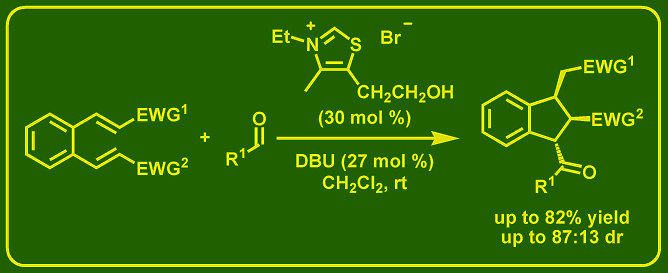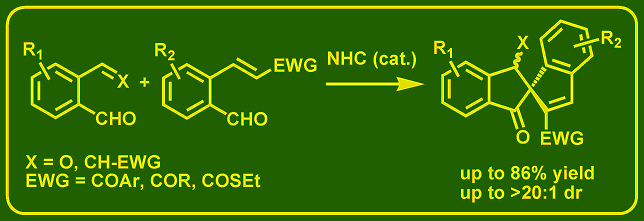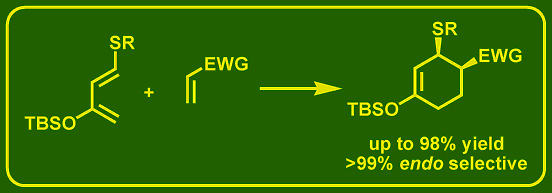Overview
Transition metal catalysts and enzymes have long dominated the field of asymmetric catalysis. In recent years, however, an alternative approach has emerged: organocatalysis. Organocatalysts can be broadly defined as small organic (metal-free) molecules capable of catalyzing organic transformations. Several reasons can explain the excitement generated by this class of catalysts; they are usually stable, readily available, inexpensive, and non-toxic. Also, the mechanism through which they exert their catalytic action is often conceptually different from transition metal catalysts and closer to their enzymatic counterparts. Most importantly, many asymmetric transformations that have proven elusive with traditional approaches have been successfully achieved with organocatalysts.
N-Heterocyclic carbene (NHC) catalysis
We have developed new ring expansion reactions of oxa- and azacycloalkane-2-carboxaldehydes providing lactones and lactams, respectively. A variety of functionalized 5-, 6-, and 7-membered heterocycles can be obtained. These reactions were found to be highly sensitive to the electronic nature of the NHC catalyst. We are currently exploring the mechanistic details of these reactions, which we think involve hydrogen bonding interactions in the rate-determining step.

Wang, L.; Thai, K.; Gravel, M. "NHC-Catalyzed Ring Expansion of Oxacycloalkane-2-Carboxaldehydes: A Versatile Synthesis of Lactones", Org. Lett. 2009, 11, 891-893. doi free e-print
Thai, K.; Wang, L.; Dudding, T.; Bilodeau, F.; Gravel, M. "NHC-Catalyzed Intramolecular Redox Amidation for the Synthesis of Functionalized Lactams", Org. Lett. 2010, 12, 5708-5711. doi free e-print
The Stetter reaction consists of the umpolung conjugate addition of an aldehyde onto a suitable Michael acceptor. Although it was discovered in the early 1970s, it has found few applications in organic synthesis. An interesting aspect of the postulated mechanism is the involvement of an enolate intermediate. We have recently found that this intermediate can be used productively in domino reactions, such as in the synthesis of trisubstituted indane and bis spiro-indane derivatives. We are currently investigating further domino NHC-catalyzed reactions as well as enantioselective versions of these reactions.

Sánchez-Larios, E.; Gravel, M. "Diastereoselective Synthesis of Indanes via a Domino Stetter-Michael Reaction", J. Org. Chem. 2009, 74, 7536-7539. doi free e-print

Sánchez-Larios, E.; Holmes, J. M.; Daschner, C. L.; Gravel, M. "NHC-Catalyzed Spiro Bis-Indane Formation via Domino Stetter-Aldol-Michael and Stetter-Aldol-Aldol Reactions", Org. Lett. 2010, 12, 5772-5775. doi free e-print
Sánchez-Larios, E.; Holmes, J. M.; Daschner, C. L.; Gravel, M. "Synthesis of Spiro Bis-Indanes via Domino Stetter-Aldol-Michael and Stetter-Aldol-Aldol Reactions: Scope and Limitations", Synthesis 2011, 1896-1904. (invited article) doi
Hydrogen bonding catalysis
Hydrogen bonding has only recently begun to be recognized as a useful source of activation for a variety of electrophiles. The most popular family of catalysts belonging to this class is represented by the thioureas. Despite the numerous reported uses of thioureas in catalysis, some serious drawbacks limit their widespread use in organic synthesis. In principle, the main drawbacks could overcome by an increase in the hydrogen bonding ability of these catalysts. We are currently exploring new classes of hydrogen bonding catalysts that will bring this type of catalysis to a more broadly useful level.

Thai, K.; Gravel, M. "Design, Synthesis, and Application of Chiral Electron-Poor Guanidines as Hydrogen-Bonding Catalysts for the Michael Reaction", Tetrahedron: Asymmetry 2010, 21, 751-755. doi
Thai, K.; Clement, C. W.; Gravel, M. "A Simple One-Pot Synthesis of Triflyl Guanidines: Access to Highly Substituted Electron-Poor Guanidines", Tetrahedron Lett. 2009, 50, 6540-6542. doi
Diels-Alder reactions
The Diels-Alder reaction plays a central role in organic synthesis. Among its many remarkable features is the ability to form up to four new stereogenic centres in a single step. A wide variety of chiral Lewis acids have been developed for this venerable reaction, yet many significant limitations persist. An alternative approach to the catalysis of Diels-Alder reactions lies in the activation of the diene by use of a Lewis base. We have been exploring different functional groups (FG) that can act as handles for Lewis base activation.

We have recently developed a new class of highly reactive dienes, the 1-alkylthio-3-silyloxybutadienes. A practical synthetic route to these substrates was shown from readily available reagents. They were found to undergo intermolecular Diels-Alder reactions even at room temperature and in high regio- and endo selectivity.

Holmes, J. M.; Albert, A. L.; Gravel, M. "Practical Synthesis and Highly Diastereoselective Diels-Alder Reactions of 1-Alkylthio-3-silyloxybutadienes", J. Org. Chem. 2009, 74, 6406-6409. doi free e-print

